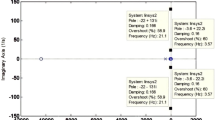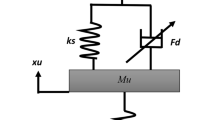Abstract
Suspension systems are essential parts in vehicles because of their usefulness for riding comfort and safety of passengers. Suspension system is used to isolate the road disturbance experienced by the tires from being transmitted to the passengers. The main objective of this paper is to propose a new intelligent control scheme based on using fuzzy logic and artificial bee colony (ABC) optimization algorithm to improve the performance of suspension systems. Effects of the nonlinearities forces that exist in damper, spring and actuator have been considered in this paper. The forces between the body of the vehicle and tires are generated using nonlinear active suspension systems. Also, the parametric uncertainty in the spring, damper and actuator has been taken into account; therefore, robust control scheme should be utilized. This necessitates a very fast and accurate controller to meet as many control objectives as possible. This paper deals with fuzzy technique to design a robust control scheme. The parameters of membership functions of fuzzy controllers have been tuned by using ABC optimization algorithm. The advantage of proposed controller is that it can handle the nonlinearities faster than other conventional controllers. The proposed control scheme attempts to minimize the vibration on each corner of the vehicle by feeding suitable forces to suspension system when passing on rough road. The comparison between passive and active suspension systems with the proposed ABCF control scheme is studied in order to illustrate the effectiveness of ABCF control scheme in terms of improving the ride comfort and safety of traveling passengers.













Similar content being viewed by others
Abbreviations
- M s :
-
Is the sprung mass (kg)
- M us5 :
-
Is the passenger seat mass (kg)
- M us1, M us2 :
-
Are the front left and front right side unsprung mass, respectively (kg)
- M us3, M us4 :
-
Are the rear left and rear right side unsprung mass, respectively (kg)
- k s5 :
-
Is the passenger seat stiffness (N/m)
- k s1, k s2 :
-
Are the front left and front right side spring stiffness, respectively (N/m)
- k s3, k s4 :
-
Are the rear left and rear right side spring stiffness, respectively (N/m)
- k t1, k t2 :
-
Are the front left and front right side tire stiffness, respectively (N/m)
- k t3, k t4 :
-
Are the rear left and rear right side tire stiffness, respectively (N/m)
- c s5 :
-
Is the passenger seat damping coefficient (N/m)
- c s1, c s2 :
-
Are the front left and front right side damping coefficient, respectively (N/m)
- c s3, c s4 :
-
Are the rear left and rear right side damping coefficient, respectively (N/m)
- c t1, c t2 :
-
Are the front left and front right side tire damping coefficient, respectively (N/m)
- c t3, c t4 :
-
Are the rear left and rear right side tire damping coefficient, respectively (N/m)
- l 1 and l 2 :
-
Are the distance between the center of gravity of the sprung mass and center of front and rear wheel axle, respectively (m)
- l s :
-
Is the distance of passenger seat position from the center of gravity (m)
- b :
-
Is the distance between the front and rear wheels (m)
- b s :
-
Is the distance of passenger seat position from the center of gravity of the vehicle (m)
References
Abedinia O, Wyns B, Ghasemi A (2011) Robust fuzzy PSS design using ABC. In: IEEE 10th international conference on environment and electrical engineering (EEEIC)
Alam MS, Islam MM (2011) Artificial bee colony algorithm with self-adaptive mutation: a novel approach for numeric optimization. In: IEEE region 10 conference in TENCON, pp 49–53
Aldair AA (2012) Neurofuzzy controller based full vehicle nonlinear active suspension systems. Ph.D. dissertation, University of Sussex
Al-Holou N, Weaver J, Joo DS (1996) Adaptive fuzzy logic based controller for an active suspension system. In: IEEE 39th Midwest symposium on circuits and system, vol 2, pp 583–586
Ansari FA, Taparia R (2013) Modeling, analysis and control of active suspension system using sliding mode control and disturbance observer. Int J Sci Res Publ 3(1):1–6
Bai Y, Wang D (2006) Fundamentals of fuzzy logic control-fuzzy sets, fuzzy rules and defuzzifications, Advanced fuzzy logic technologies in industrial applications. Springer, London, pp 17–36
Buckley JJ, Ying H (1989) Fuzzy controller theory: limit theorems for linear fuzzy control rules. Automatic 25(3):469–472
Güçlü R (2003) Active control of seat vibrations of a vehicle model using various suspension alternatives. Turk J Eng Environ Sci 27(6):361–374
Guclu R, Gulez K (2008) Neural network control of seat vibrations of a non-linear full vehicle model using PMSM. J Math Comput Model 47(11):1356–1371
Karaboga D (2005) An idea based on honey bee swarm for numerical optimization, vol 200. Technical report-tr06
Karaboga D, Basturk B (2007) A powerful and efficient algorithm for numerical function optimization: artificial bee colony (ABC) algorithm. J Glob Optim 39(3):459–471
Karaboga D, Akay B, Celal Ozturk (2007) Artificial bee colony (ABC) optimization algorithm for training feed-forward neural networks. In: International conference on modeling decisions for artificial intelligence. Springer, Berlin, pp 318–329
Kishor A, Singh PK (2015) Comparative study of artificial bee colony algorithm and real coded genetic algorithm for analyzing their performances and development of a new algorithmic framework. In: IEEE second international conference on soft computing and machine intelligence, pp 15–19
Lajqi S, Pehan S (2012) Designs and optimizations of active and semi-active non-linear suspension systems for a terrain vehicle. J Mech Eng 58(12):732–743
Layne JR, Passino KM (1996) Fuzzy model reference learning control. J Intell Fuzzy Syst 4(1):33–47
Lee CC (1990a) Fuzzy logic in control systems: fuzzy logic controller-part 1. IEEE Trans Syst Man Cybern 20(2):404–418
Lee CC (1990b) Fuzzy logic in control systems: fuzzy logic controller-part II. IEEE Trans Syst Man Cybern 20(2):419–435
Liao W, Hu Y, Wang H (2014) Optimization of PID control for DC motor based on artificial bee colony algorithm. In: IEEE international conference on advanced mechatronic systems, pp 23–27
Lin J, Lian RJ (2011) Intelligent control of active suspension systems. IEEE Trans Ind Electron 58(2):618–628
Pareek S, Kishnani M, Gupta R (2014) Application of artificial bee colony optimization for optimal PID tuning. In: IEEE international conference on advances in engineering and technology research
Pelusi D (2011) Optimization of a fuzzy logic controller using genetic algorithms. In: IEEE 3rd international conference on intelligent human–machine systems and cybernetics (IHMSC), vol 2, pp 143–146
Rajamani R, Hedrick JK (1995) Adaptive observers for active automotive suspension: theory and experiment. IEEE Trans Control Syst Technol 3(1):86–92
Rao TR, Anusha P (2013) Active suspension system of a 3 DOF quarter car using fuzzy logic control for ride comfort. In: IEEE international conference on control, automation, robotics and embedded systems (CARE), pp 1–6
Ren J, Yuan S, Mu B (2016) Parallel modified artificial bee colony algorithm for solving conditional nonlinear optimal perturbation. In: IEEE 18th international conference on high performance computing and communications; IEEE 14th international conference on smart city; IEEE 2nd international conference on data science and systems, pp 333–340
Riaz S, Khan L (2016) Adaptive soft computing strategy for ride quality improvement with anti-lock braking system. In: Proceedings of the IEEE international Bhurban conference on applied sciences and technology (IBCAST), pp 280–285
Saeed BI, Mehrdadi B (2011) Zero overshoot and fast transient response using a fuzzy logic controller. In: IEEE 17th international conference on automation and computing (ICAC) London, pp 116–120. ISBN: 9781467300001
Singh D, Aggarwal ML (2016) Active vibration control of passenger seat with HFPIDCR controlled suspension alternatives. World Acad Sci Eng Technol Int J Mech Aerosp Ind Mechatron Manuf Eng 10(5):954–961
Turanoglu E, Ozceylan E, Kiran MS (2011) Particle swarm optimization and artificial bee colony approaches to optimize of single input–output fuzzy membership functions. In: Proceedings of the 41st international conference on computers & industrial engineering, pp 542–547
Yan G, Li C (2011) An effective refinement artificial bee colony optimization algorithm based on chaotic search and application for PID control tuning. J Comput Inf Syst 7(9):3309–3316
Yue LJ, Tang CY, Li H (2008) Research on vehicle suspension systems based on fuzzy logic control. In: Proceedings of the IEEE international conference on automation and logistics (ICAL) Qingdao, China, pp 1817–1821
Author information
Authors and Affiliations
Corresponding author
Appendix: Variable design parameters values
Appendix: Variable design parameters values
Parameters | Values | Unit |
|---|---|---|
ks1, ks2 | 19,960 | N/m |
ks3, ks4 | 17,500 | N/m |
k s5 | 1,00,000 | N/m |
kt1, kt2, kt3, kt4 | 1,75,500 | N/m |
cs1, cs2 | 1290 | N s/m |
cs3, cs4 | 1620 | N s/m |
c s5 | 500 | N s/m |
ct1, ct2, ct3, ct4 | 14.6 | N s/m |
M s | 1460 | kg |
Mus1, Mus2 | 40 | kg |
Mus3, Mus4 | 35.5 | kg |
M us5 | 100 | kg |
J x | 460 | kg m2 |
J y | 2460 | kg m2 |
l s | 0.234 | m |
l 1 | 1.011 | m |
l 2 | 1.803 | m |
b s | 0.375 | m |
b | 1.51 | m |
\(\zeta\) | 0.1 | – |
Rights and permissions
About this article
Cite this article
Aldair, A.A., Alsaedee, E.B. & Abdalla, T.Y. Design of ABCF Control Scheme for Full Vehicle Nonlinear Active Suspension System with Passenger Seat. Iran J Sci Technol Trans Electr Eng 43 (Suppl 1), 289–302 (2019). https://doi.org/10.1007/s40998-018-0134-9
Received:
Accepted:
Published:
Issue Date:
DOI: https://doi.org/10.1007/s40998-018-0134-9




